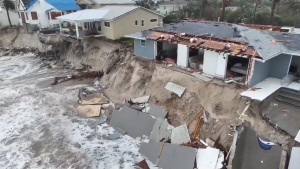Legislature, FEMA coming through

A tarped home in Ft. Myers awaiting repair from Hurricane Ian damage, December 12, 2022. Courtesy, AmeriCorps
The Florida Legislature begins a special session today to consider greatly bolstering disaster recovery efforts from Hurricanes Ian and Nicole as the death toll rises yet again, while local communities share the barriers to storm recovery. Plus, an anticipated boost from FEMA for Florida’s mitigation efforts to avoid future storm damage. It’s all in this week’s Disaster Management Digest.
Special Session: Legislative leaders this past Friday called a special session of the legislature to begin today (February 6) and run through this week. Among the issues: Emergency Management post Hurricanes Ian and Nicole in an effort to fast-track money for needed recovery. House Majority Leader Ben Albritton (R-Bartow) has filed SB 2-B. The bill creates the Local Government Emergency Bridge Loan Program within the Department of Economic Opportunity to provide interest-free loans in lump sums to local governments impacted by either hurricane. The bill appropriates $50 million in nonrecurring funds from General Revenue and transfers $650 million to the Emergency Preparedness and Response Fund to be used for responding to a declared state of emergency. You can read more in the bill analysis. The funding would be in addition to the $250 million in disaster recovery authorized in SB 4-A in the recent December special session. We also learned of another death from Ian this past week in Lee County, where the Cat-4 storm made landfall, bringing the Florida death toll now to 149 people.
Barriers to Recovery: The Senate Select Committee on Resiliency, chaired by Senator Albritton, met the week before last and heard lessons from 2018’s Hurricane Michael, the Cat-5 storm that clobbered parts of the Florida Panhandle. Robert Majka, the County Manager for Bay County, which was ground zero, provided an overview of the barriers to hurricane recovery. He recommended contractors be state licensed at the local level through tax collector offices to help speed repairs. He also said the state should develop some type of credit rating for local governments so the state can more speedily approve funds to those with a demonstrated track record of either fiscal responsibility or financial capability. He said municipalities should identify their financial vulnerabilities regarding storm recovery well ahead of the next storms. Majka also touched on school board provisions in relation to Michael storm recovery and their financial relationship with FEMA as well as the lack of subject matter experts on the local level. He said the amount of workload put on local jurisdictions who lack the caliber of knowledge and access the state or federal agencies do makes it difficult to recover. Having pre-event disaster expert consultant contracts he said, would help. The committee also heard testimony from all three major power companies on storm hardening, with FP&L saying 500,000 outages were avoided due to smart grid technology.
Information Technology (IT) also plays into successful recovery. The state Division of Emergency Management (DEM) testified recently before a Senate Appropriations Committee that last year’s $2.7 million investment for DEM’s IT expansion brought a return on investment of $625 million as DEM was able to attain funding for storm survivors in the first 100 days following Hurricane Ian, an unprecedented accomplishment.

A still image from drone video shows one of seven oceanfront homes in Wilbur-by-the-Sea collapsing into the Atlantic Ocean after Hurricane Nicole. Courtesy Bridgepoint Global
FEMA Boost: It is anticipated soon that FEMA will be allocating about $1 billion to Florida communities impacted by the recent hurricanes. The money will go to mitigation measures to make those areas more resilient to future storms and suffer fewer catastrophic losses. This is federal Stafford Act money. Last month we reported on FEMA’s Building Resilient Infrastructure and Communities (BRIC) program making available $2.3 billion for hazard mitigation projects nationwide. We at LMA will be working with resilience experts across the state to help plan the smart use of this funding. As Dr. David Prevatt pointed out in his December newsletter article, a long-term vision and commitment is needed to make sure some of our most vulnerable communities are around in the 22nd century.
FEPA Conference: I had the pleasure of attending the Florida Emergency Preparedness Association (FEPA) conference in Orlando last week, on behalf of the Disaster Recovery Coalition of America, where I serve as policy advisor. The conference was attended by emergency managers from Florida’s 67 counties, along with companies and vendors exhibiting their products and services. In this television interview I explain the constantly evolving disaster recovery industry and how it helps people after hurricanes and even before. I also share some specifics about potential new applications for drone technology and other ideas discussed at the conference, including mitigation and streamlining disaster response offered by Kevin Guthrie, Florida’s chief of emergency management. Check it out!
LMA Newsletter of 2-6-23

